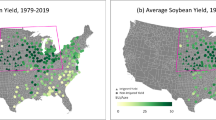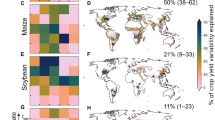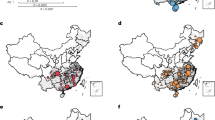Abstract
Many varieties of short-duration extreme weather pose a threat to global crop production, food security and farmer livelihoods1,2,3,4. Hourly exposure to extreme heat has been identified as detrimental to crop yields1,5; however, the influence of hourly rainfall intensity and extremes on yields remains unknown4,6,7. Here, we show that while maize and soy yields in the United States are severely damaged by the rarest hourly rainfall extremes (≥50 mm hr−1), they benefit from heavy rainfall up to 20 mm hr−1, roughly the heaviest downpour of the year on average. We also find that yields decrease in response to drizzle (0.1–1 mm hr−1), revealing a complex pattern of yield sensitivity across the range of hourly intensities. We project that crop yields will benefit by ~1–3% on average due to projected future rainfall intensification under climate warming8,9, slightly offsetting the larger expected yield declines from excess heat, with the benefits of more heavy rainfall hours outweighing the damages due to additional extremes. Our results challenge the view that an increasing frequency of high-intensity rainfall events poses an unequivocal risk to crop yields2,7,10 and provide insights that may guide adaptive crop management and improve crop models.
This is a preview of subscription content, access via your institution
Access options
Access Nature and 54 other Nature Portfolio journals
Get Nature+, our best-value online-access subscription
$29.99 / 30 days
cancel any time
Subscribe to this journal
Receive 12 print issues and online access
$209.00 per year
only $17.42 per issue
Buy this article
- Purchase on Springer Link
- Instant access to full article PDF
Prices may be subject to local taxes which are calculated during checkout




Similar content being viewed by others
Data availability
All datasets supporting the results of this paper are freely available from the references and links listed in Supplementary Table 4. The compiled dataset is available at https://github.com/clesk/crop-hourly-rainfall. Source data are provided with this paper.
Code availability
The processing and analysis codes are hosted at https://github.com/clesk/crop-hourly-rainfall.
References
Schlenker, W. & Roberts, M. J. Nonlinear temperature effects indicate severe damages to U.S. crop yields under climate change. Proc. Natl Acad. Sci. USA 106, 15594–15598 (2009).
Vogel, E. et al. The effects of climate extremes on global agricultural yields. Environ. Res. Lett. 14, 054010 (2019).
Lesk, C., Rowhani, P. & Ramankutty, N. Influence of extreme weather disasters on global crop production. Nature 529, 84–87 (2016).
Troy, T. J., Kipgen, C. & Pal, I. The impact of climate extremes and irrigation on US crop yields. Environ. Res. Lett. 10, 054013 (2015).
Lobell, D. B. et al. The critical role of extreme heat for maize production in the United States. Nat. Clim. Change 3, 497–501 (2013).
van der Velde, M., Wriedt, G. & Bouraoui, F. Estimating irrigation use and effects on maize yield during the 2003 heatwave in France. Agric. Ecosyst. Environ. 135, 90–97 (2010).
Rosenzweig, C., Tubiello, F. N., Goldberg, R., Mills, E. & Bloomfield, J. Increased crop damage in the US from excess precipitation under climate change. Glob. Environ. Change 12, 197–202 (2002).
O’Gorman, P. & Schneider, T. The physical basis for increases in precipitation extremes in simulations of 21st-century climate change. Proc. Natl Acad. Sci. USA 106, 14773–14777 (2009).
Westra, S. et al. Future changes to the intensity and frequency of short-duration extreme rainfall. Rev. Geophys. 52, 522–555 (2014).
Zhu, X. & Troy, T. J. Agriculturally relevant climate extremes and their trends in the world’s major growing regions. Earth’s Future 6, 656–672 (2018).
Ray, D. K., Gerber, J. S., Macdonald, G. K. & West, P. C. Climate variation explains a third of global crop yield variability. Nat. Commun. 6, 5989 (2015).
Lobell, D. B. & Field, C. B. Global scale climate–crop yield relationships and the impacts of recent warming. Environ. Res. Lett. 2, 014002 (2007).
Urban, D. W., Roberts, M. J., Schlenker, W. & Lobell, D. B. The effects of extremely wet planting conditions on maize and soybean yields. Clim. Change 130, 247–260 (2015).
Li, Y., Guan, K., Schnitkey, G. D., Delucia, E. & Peng, B. Excessive rainfall leads to maize yield loss of a comparable magnitude to extreme drought in the United States. Glob. Change Biol. 25, 2325–2337 (2019).
Lobell, D. B. & Burke, M. B. Why are agricultural impacts of climate change so uncertain? The importance of temperature relative to precipitation. Environ. Res. Lett. 3, 034007 (2008).
Lobell, D. B. & Gourdji, S. M. The influence of climate change on global crop productivity. Plant Physiol. 160, 1686–1697 (2012).
Palecki, M. A., Angel, J. R. & Hollinger, S. E. Storm precipitation in the United States. Part I: meteorological characteristics. J. Appl. Meteorol. 44, 933–946 (2005).
Thorp, J. M. & Scott, B. C. Preliminary calculations of average storm duration and seasonal precipitation rates for the northeast sector of the United States. Atmos. Environ. 16, 1763–1774 (1982).
Zhang, W., Villarini, G., Scoccimarro, E. & Vecchi, G. A. Stronger influences of increased CO2 on subdaily precipitation extremes than at the daily scale. Geophys. Res. Lett. 44, 7454–7471 (2017).
Lepore, C., Allen, J. T. & Tippett, M. K. Relationships between hourly rainfall intensity and atmospheric variables over the contiguous United States. J. Clim. 29, 3181–3197 (2016).
Ashraf, M. & Habib-ur-Rehman. Interactive effects of nitrate and long-term waterlogging on growth, water relations, and gaseous exchange properties of maize (Zea mays L.). Plant Sci. 144, 35–43 (1999).
Martínez-Casasnovas, J. A., Ramos, M. C. & Ribes-Dasi, M. Soil erosion caused by extreme rainfall events: mapping and quantification in agricultural plots from very detailed digital elevation models. Geoderma 105, 125–140 (2002).
Meisinger, J. J. & Delgado, J. A. Principles for managing nitrogen leaching. J. Soil Water Conserv. 57, 485–498 (2002).
Zahran, H. H. Rhizobium–legume symbiosis and nitrogen fixation under severe conditions and in an arid climate. Microbiol. Mol. Biol. Rev. 63, 968–989 (1999).
Dastane, N. G. Effective Rainfall in Irrigated Agriculture Irrigation and Drainage Paper No. 25 (FAO, 1978).
Van Elewijk, L. Stemflow on maize: a stemflow equation and the influence of rainfall intensity on stemflow amount. Soil Technol. 2, 41–48 (1989).
Munkvold, G. P. Epidemiology of Fusarium diseases and their mycotoxins in maize ears. Eur. J. Plant Pathol. 109, 705–713 (2003).
Harvell, C. D. et al. Climate warming and disease risks for terrestrial and marine biota. Science 296, 2158–2162 (2002).
Lenderink, G. & Van Meijgaard, E. Increase in hourly precipitation extremes beyond expectations from temperature changes. Nat. Geosci. 1, 511–514 (2008).
Berg, P., Moseley, C. & Haerter, J. O. Strong increase in convective precipitation in response to higher temperatures. Nat. Geosci. 6, 181–185 (2013).
Prein, A. F. et al. The future intensification of hourly precipitation extremes. Nat. Clim. Change 7, 48–52 (2017).
Chou, C., Chen, C. A., Tan, P. H. & Chen, K. T. Mechanisms for global warming impacts on precipitation frequency and intensity. J. Clim. 25, 3291–3306 (2012).
Kendon, E. J. et al. Heavier summer downpours with climate change revealed by weather forecast resolution model. Nat. Clim. Change 4, 570–576 (2014).
Zhao, C. et al. Temperature increase reduces global yields of major crops in four independent estimates. Proc. Natl Acad. Sci. USA 114, 9326–9331 (2017).
de Bruyn, L. P. & de Jager, J. M. A meteorological approach to the identification of drought sensitive periods in field crops. Agric. Meteorol. 19, 35–40 (1978).
Lin, Y. GCIP/EOP Surface: Precipitation NCEP/EMC 4KM Gridded Data (GRIB) Stage IV Data (UCAR/NCAR—Earth Obs. Lab., 2011); https://doi.org/10.5065/D6PG1QDD
USDA Quickstats (USDA, 2018); http://quickstats.nass.usda.gov
Thornton, P. E. et al. Daymet: Daily Surface Weather Data on a 1-km Grid for North America Version 2 (ORNL DAAC, 2016).
Butler, E. E. & Huybers, P. Adaptation of US maize to temperature variations. Nat. Clim. Change 3, 68–72 (2013).
Krajewski, W. F. & Smith, J. A. Radar hydrology: rainfall estimation. Adv. Water Resour. 25, 1387–1394 (2002).
Karl, T., Nicholls, N. & Ghazi, A. Workshop on indices and indicators for climate extremes precipitation. Clim. Change 42, 3–7 (1999).
Lau, W. K., Wu, H. & Kim, K. A canonical response of precipitation characteristics to global warming from CMIP5 models. Geophys. Res. Lett. 40, 3163–3169 (2013).
Acknowledgements
This material is based on work supported by the National Science Foundation Graduate Research Fellowship under grant no. DGE–1644869. Additional funding was provided by the Department of Interior Northeast Climate Adaptation Science Center and grant no. G16AC00256 from the United States Geological Survey. We thank N. Lenssen, J. Mankin, D. Singh, W. Anderson, R. DeFries and M. Ting for constructive feedback on the methods and results.
Author information
Authors and Affiliations
Contributions
C.L. and E.C. designed and coordinated the research and conducted the analysis. All authors discussed the results and wrote the manuscript.
Corresponding author
Ethics declarations
Competing interests
The authors declare no competing interests.
Additional information
Peer review information Nature Climate Change thanks Ethan Butler, Yan Li and Deepak Ray for their contribution to the peer review of this work.
Publisher’s note Springer Nature remains neutral with regard to jurisdictional claims in published maps and institutional affiliations.
Extended data
Extended Data Fig. 1 Correlation between the incidence of hourly rainfall intensities and seasonal total rainfall, extreme heat, and maximum daily rainfall.
Correlation coefficient of seasonal occurrence (hours) of rainfall of given intensities with seasonal total rainfall, killing degree days, and maximum daily rainfall, with annotated zones of significant positive (green) and negative (red) yield response (P < 0.05).
Extended Data Fig. 2 Regional maize and soy yield sensitivity to drizzle and heavy rainfall.
a) Schematic map of regional boundaries. Northeast is defined as latitude ≥40°N, east of 93°W, southeast as latitude <40°N, east of 93°W, and west as 93 to 104°W. b) Regional variation in the incidence of differing rainfall intensities, as percent deviation from the national mean incidence (Fig. 2). Regional mean county-level yield sensitivity (±SE) to hourly rainfall intensity per hour of exposure for c–e) maize, and f–h) soy. Extreme rainfall bins >40 mm hr−1 are omitted due to insufficient data for sample stratification. Sensitivities are plotted on symmetric logarithmic axes, with correspondingly transformed relative error bars. Green and red points indicate significant positive and negative sensitivities (two-sided P < 0.05).
Extended Data Fig. 3 Maize and soy yield sensitivity to drizzle and heavy rainfall among counties with more and less extensive irrigation.
Mean county-level yield sensitivity (±SE) to hourly rainfall intensity per hour of exposure for a, b) counties with less than 5% of crop area irrigated, and c, d) counties with more than 5% crop area irrigated (see Methods). Results are shown for maize in a) and c), and for soy in b) and d). Extreme rainfall bins >40 mm hr−1 are omitted due to insufficient data for sample stratification. Sensitivities are plotted on symmetric logarithmic axes, with correspondingly transformed relative error bars. Dark green and red points indicate significant positive and negative sensitivities (two-sided P < 0.05), while pink and light green points denote weakly significant effects (two-sided P < 0.1). The total counties analyzed is less than for the other analyses as irrigation data is not available for all counties.
Extended Data Fig. 4 Projected future incidence of heavy and extreme rainfall under climate warming.
Intensified distributions of heavy and extreme hourly rainfall under idealized warming of 1, 2 and 4 K projected by shifting the 2002–2017 baseline distribution (black curve, Fig. 2) under a) the uniform low-change scenario, b) the uniform high-change scenario, and c) the amplified scenario with greater intensification for higher intensities.
Supplementary information
Supplementary Information
Supplementary Figs. 1–8 and Tables 1–5.
Source data
Source Data Fig. 1
Source data for Fig. 1.
Source Data Fig. 2
Source data for Fig. 2.
Source Data Fig. 3
Source data for Fig. 3.
Source Data Fig. 4
Source data for Fig. 4.
Source Data Extended Data Fig. 1
Source data for Extended Data Fig. 1.
Source Data Extended Data Fig. 2
Source data for Extended Data Fig. 2.
Source Data Extended Data Fig. 3
Source data for Extended Data Fig. 3.
Source Data Extended Data Fig. 4
Source data for Extended Data Fig. 4.
Rights and permissions
About this article
Cite this article
Lesk, C., Coffel, E. & Horton, R. Net benefits to US soy and maize yields from intensifying hourly rainfall. Nat. Clim. Chang. 10, 819–822 (2020). https://doi.org/10.1038/s41558-020-0830-0
Received:
Accepted:
Published:
Issue Date:
DOI: https://doi.org/10.1038/s41558-020-0830-0
This article is cited by
-
Nitrogen cycles in global croplands altered by elevated CO2
Nature Sustainability (2023)
-
Contrasting impacts of dry versus humid heat on US corn and soybean yields
Scientific Reports (2023)
-
Sustainable irrigation and climate feedbacks
Nature Food (2023)
-
Extreme rainfall reduces one-twelfth of China’s rice yield over the last two decades
Nature Food (2023)
-
Increased probability of hot and dry weather extremes during the growing season threatens global crop yields
Scientific Reports (2023)



